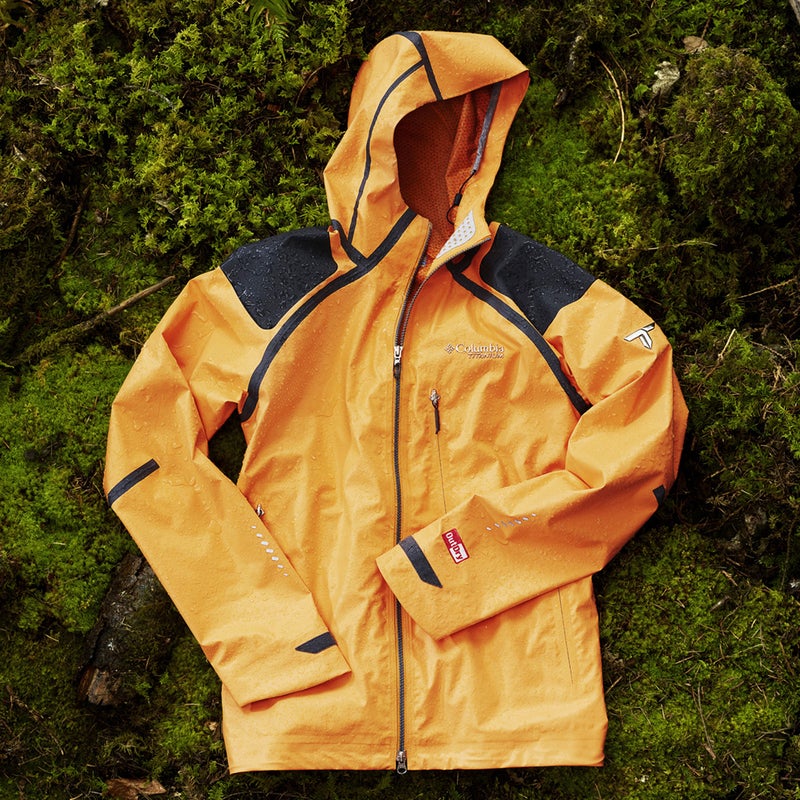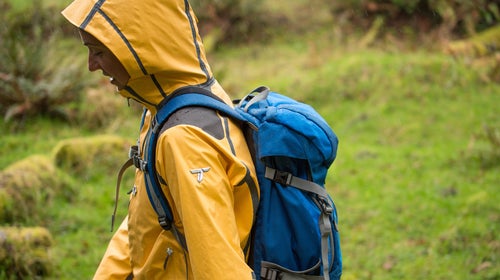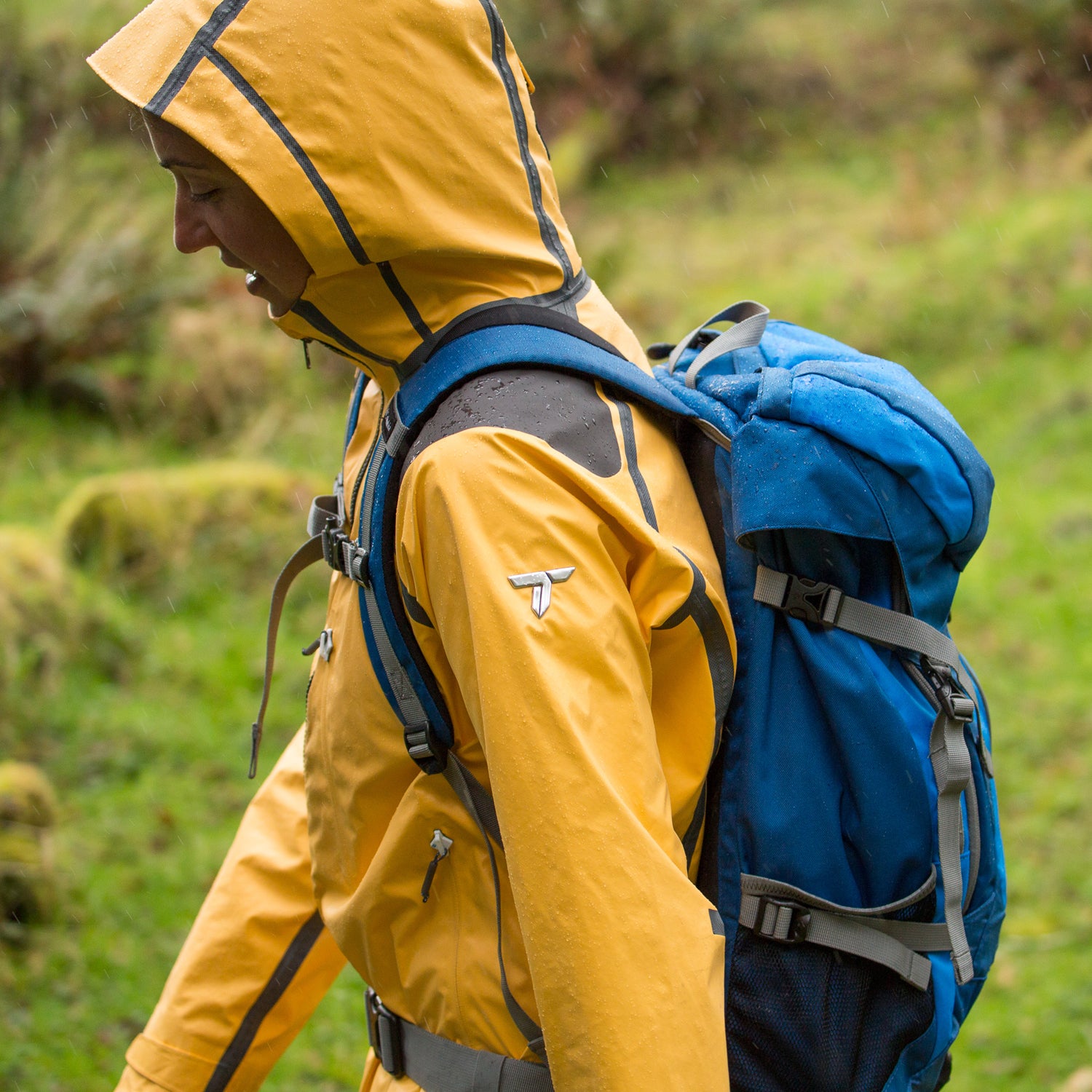Most rain jackets between a durable exterior fabric and a softer next-to-skin layer. The membrane is what keeps you dry, but it has to be in between the layers of fabric because it’s extremely fragile. Brushed on a tree branch, a raw membrane would rip to pieces, and a membrane against your skin would clog with your sweat, dirt, and anything else that comes into contact with it.
That's why companies use an exterior fabric, but that layer has its own problems: It can wet out, causing the inside of the jacket to feel cold and clammy. Also, when combined with the glue that holds the layers together, it hinders breathability.

��DZ��ܳ�������’s��, on the other hand, “is a new approach to rainwear,” says Woody Blackford, the company’s vice president of innovation and design. In its new rain jackets, Columbia did away with that outer layer, putting the waterproof membrane on the outside of the jacket. Designers boosted durability by fusing a thin, diamond-shaped rubbery film to the perforated waterproof-breathable membrane.
That outer layer is highly abrasion-resistant—the jacket was miraculously unscathed even after several hours of bushwhacking through tight conifers on the backside of Mad River Glen in Vermont’s Green Mountains—and any dirt that accumulated was easy to wipe off with a sponge.
The other benefit of this design: There’s no glue holding the layers together, which means it’s super-breathable. Instead, Columbia bonded the interior fabric to the dual-layer membrane with heat and pressure. The inside fabric is soft and wicking, not clammy, against your skin. It also disperses beads of sweat, which makes it easier for the jacket to move moisture to the outside with the help of your body heat.
So how does it actually work? Read on.
The Takeaway
The Good: The most breathable rain jacket we’ve tested, thanks to a brand-new waterproof concept called that prevents the shell from ever wetting out. A tough, rubbery exterior is super abrasion-resistant, and it doesn’t look dirty as quickly as other shells. (More on this below.)
The Bad: The aesthetics didn’t appeal to everyone. Columbia is using contrasting external seam taping and contrasting patches on the shoulders. This makes the jacket look techy, but it’s a look that not everyone loved.
The Verdict: A jacket best suited for people looking to do high-output activities—think hiking, trail work, or flatwater paddling—in the rain.
The Specs
- �±����:��13.4 ounces
- �ѳ����:��$400
- Intended For: Active people in extreme wet conditions.
- The Test: Two months in snow and rain in Vermont, working as well as playing.
Weatherproofing and Breathability
I wore the jacket through the rainy spring and early summer in Vermont, New York, and New Hampshire while hiking, paddling, doing trail work, and spring skiing in temps that ranged from 35 to 65 degrees Fahrenheit.
The jacket kept me dry through all of it and never got the cold, clammy feeling I associate with other shells when they get wet.
I was even able to wear this jacket skinning and biking. Did I sweat? Yes. But I found that I could wear this jacket longer than its competitors. (See below.) The dual-direction pit zips helped with additional venting when I needed it.
Bonus points: We loved that the waterproof zips were easy to operate with one hand.
Packability
The jacket’s packability and weight were comparable to a . It’s not the lightest jacket on the market, at 13.4 ounces, but it’s reasonably light and super-durable. In your pack, it stuffs down to about the size of a grapefruit.
Size and Fit
The jacket runs true to size. I wear a medium in Patagonia, The North Face, and Mountain Hardwear, and this jacket was similarly sized. It’s cut like a standard hiking shell or rain jacket—about hip length.
Durability
Even after a week of walking with a heavy pack, there was no visible breakdown of the waterproofing under the shoulder straps or in other high-wear spots at the hips.
The Competition
Columbia claims that in a rain test with Patagonia’s , Marmot’s , Arcteryx’s , and The North Face’s , “all competitors showed signs of wet out in less than one hour of constant rain. “OutDry Extreme did not wet out in over 24 hours of continuous rain testing.” (With abrasion, the Columbia jacket may even “win” sooner.)
I didn’t sweat as fast as I normally would in other waterproof-breathable rain jackets I’ve tested regardless of the membrane. And during a rainy weekend of backpacking in New York’s Adirondacks, I never got that wet feeling from the outer fabric soaking through.
There’s gripper elastic in the waist, but no snow skirt—Columbia is positioning this as a rain jacket for now, not as a winter shell or ski jacket. Though it’s versatile enough to wear in any season, it definitely looks like a rain slicker—rubbery and shiny.
Bottom Line
We like it. It’s best for hiking because of the cut and features—standard hiking-shell length, two hand pockets, a chest stash pocket, and a hood with a visor. Even though Columbia calls it a rain jacket, you could certainly wear it in winter as well—we did. We’d also love to see a version cut specifically for cycling.


